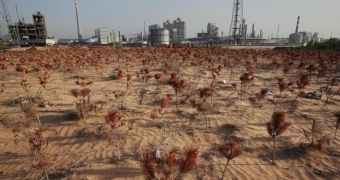According to environmental group Greenpeace, China is seriously considering adding several dozen coal-to-gas plants to its energy sector. The organization warns that this could translate into yearly carbon dioxide emissions of over one billion tons.
On its website, Greenpeace explains that, until now, the country has implemented two coal-to-gas projects, i.e. Datang's Inner Mongolia Keqi plant and Qinghua's Xinjiang plant.
However, it appears that, within the next decade, as many as 50 such facilities could be operational across the China's territory. The organization expects that the annual carbon emissions of these plants will amount to 1.087 billion tons.
“There could be 50 coal-to-gas projects operational within the next decade, producing 225 billion cubic meters of synthetic natural gas [SNG] per year, if all of the planned ones go ahead,” the environmental group notes.
“These 50 would emit around 1.087 billion tons of CO2 per year if they are developed, according to the new analysis. To put this in perspective, it is around one eighth of China's CO2 emissions in 2011 (8.71 billion tons),” it adds.
Greenpeace says that, of these 50 coal-to-gas facilities that China hopes to build and put to work within the next decade, three are already under construction. Another 16 projects have been given the thumbs up, and 11 are waiting for approval.
Provided that China settles for adding just 21 such plants to its energy sector, i.e. the ones already operational, the ones under construction and the ones that have secured approval, the country will still experience a noteworthy increase in yearly CO2 emissions.
More precisely, Greenpeace estimates that just 21 such plants will be more than enough to put about 0.402 billion tons of carbon in our planet's atmosphere on a yearly basis. This will fuel both climate change and global warming.
China is thinking about investing heavily in coal-to-gas technology in an attempt to curb air pollution levels. Still, the organization maintains that developing this many coal-to-gas plants will not only do nothing to benefit air quality, but will also take its toll on water reserves.
This is because, as shown by several investigations into the environmental impact of this technology, coal-to-gas plants more often than not require about five to six tons of water to produce approximately 1,000 cubic meters of synthetic natural gas.
“The need to reduce smog in the eastern part of China has resulted in the idea that coal should be turned to gas in remote regions to the west, such as Inner Mongolia and Xinjiang,” the environmental group writes on its website.
Furthermore, “Unfortunately this shift has (at least) two consequences: it transfers air pollution to remote communities in northwestern China and sucks up loads of water from what is an already dry and arid region,” Greenpeace warns.

 14 DAY TRIAL //
14 DAY TRIAL //